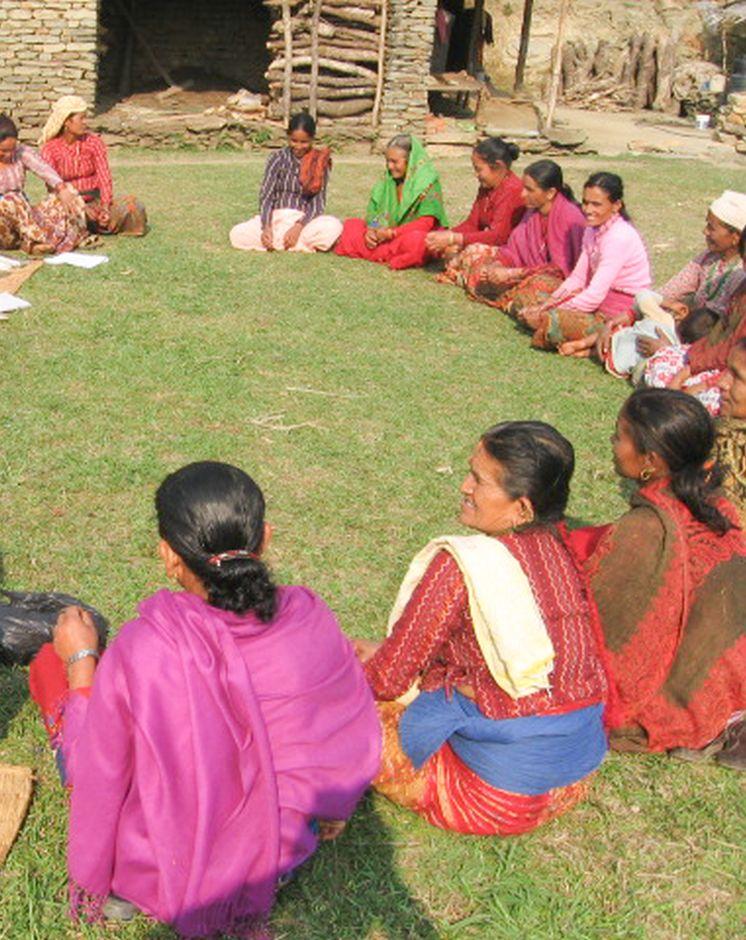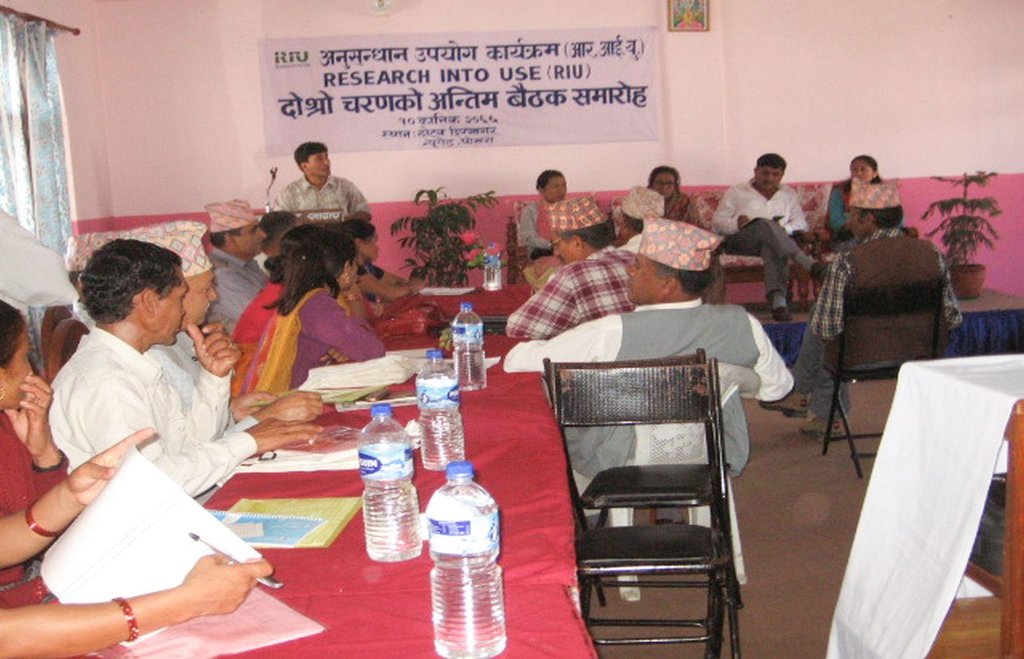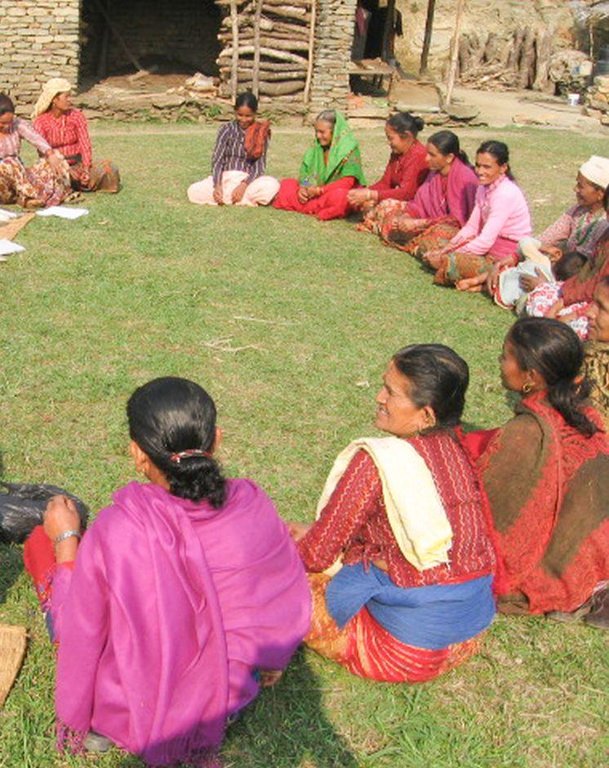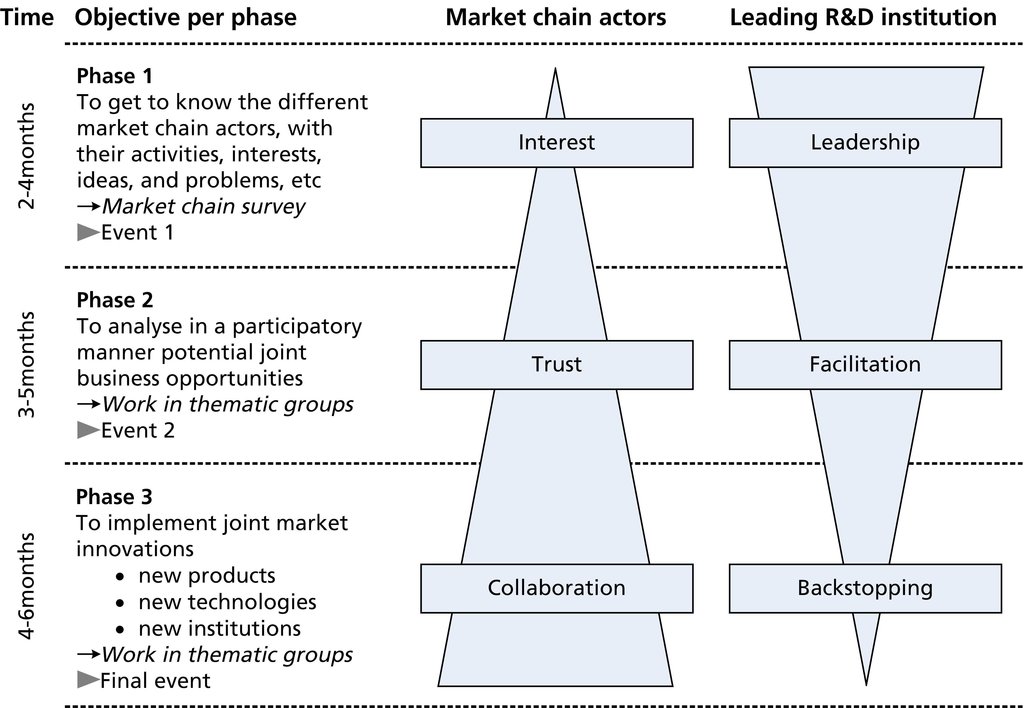Using the participatory market chain approach to help smallholder farmers market their produce [Nepal]
- Creation:
- Update:
- Compiler: Shreedip Sigdel
- Editor: –
- Reviewer: Fabian Ottiger
tarakari sahachetrama sahabhagitatmak bajar sanjal bidhi ko prayog (Main Contributor: Bharat Nepal, IDE/Nepal)
approaches_2533 - Nepal
View sections
Expand all Collapse all1. General information
1.2 Contact details of resource persons and institutions involved in the assessment and documentation of the Approach
SLM specialist:
Nepal Bharat
+977 61526537, +977 15520943 (KTM)
bnepal@idenepal.org
International Development Enterprises (IDE) Nepal, Research Into Use (RIU) Project
Regional Office, Pokhara, Kaski; PO Box No. 2674, Kathmandu, Nepal
Nepal
Name of the institution(s) which facilitated the documentation/ evaluation of the Approach (if relevant)
ICIMOD International Centre for Integrated Mountain Development (ICIMOD) - NepalName of the institution(s) which facilitated the documentation/ evaluation of the Approach (if relevant)
iDE Nepal (iDE Nepal) - Nepal1.3 Conditions regarding the use of data documented through WOCAT
When were the data compiled (in the field)?
01/03/2013
The compiler and key resource person(s) accept the conditions regarding the use of data documented through WOCAT:
Yes
1.4 Reference(s) to Questionnaire(s) on SLM Technologies
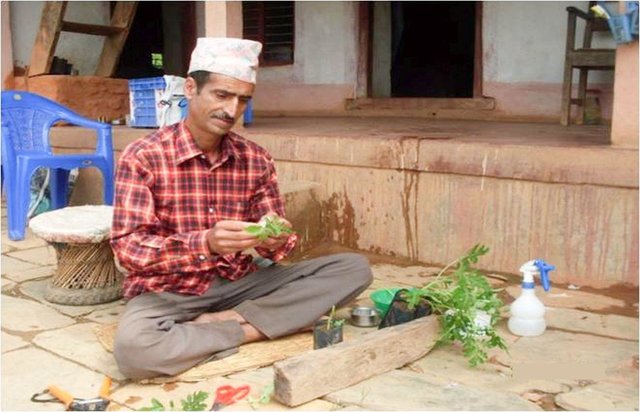
Tomato Grafting [Nepal]
Cleft grafting can be used to produce plants that are resistant to a number of pests and diseases and are often higher yielding than the original. Tomato seedlings can be easily grafted onto resistant root stock of the wild eggplant (Solanum sysimbrifolium) to produce a disease-resistant and commercially viable crop.
- Compiler: Shreedip Sigdel
2. Description of the SLM Approach
2.1 Short description of the Approach
Discussions and structured interactions between farmers and the different actors involved throughout the market chain can help to stimulate joint innovations based on shared ideas and mutual trust.
2.2 Detailed description of the Approach
Detailed description of the Approach:
Aims / objectives: Most Nepalese rural smallholder landowners are subsistence farmers; when they attempt to produce high value crops such as vegetables for income generation they are often disappointed because they end up selling their produce at local markets for marginal profits. They mostly work alone and, for the most part, their efforts are poorly rewarded, since every step of the value chain is either unmanaged, badly structured, or otherwise uncoordinated. A first step towards addressing the myriad challenges and special needs faced by these smallholder farmers can be to use an adapted version of the participatory market chain approach (PMCA). This approach can help them to improve their livelihoods by building their capacity and assisting them to coordinate and form linkages with other smallholder producers and actors all along the market chain.
Methods: The participatory market chain approach uses the tools of rapid market assessment, focus group discussions, stakeholder interviews, and interaction workshops to help identify the constraints and opportunities faced by each of the different actors in the market chain. This approach uses a set of guidelines to help achieve well-defined objectives at specific points as the programme is implemented.
Stages of implementation: Overall, the long-term objective of the PMCA is to help alleviate the poverty of smallholder producers by introducing market chain innovations, and in particular participation and collaboration among the different market chain actors. Once a given set of conditions is found to work, they can benefit a larger number of farmers if the findings are documented and disseminated among organizations and agencies who share the same goals.
The PMCA approach is executed in three phases:
Phase 1: The different actors along the market chain get to know each other. They analyse their situation with the help of market chain sketch tools. By the end of Phase 1, they form a thematic group.
Phase 2: The group analyses potential business opportunities by using a variety of tools such as: rapid market appraisal, quantitative market survey/study, and focus group discussions.
Phase 3: They put into practice the work plan that they have devised to implement the proposed innovations and continue to work on ideas for commercially viable products using the market concept and business plan development tools.
2.3 Photos of the Approach
2.5 Country/ region/ locations where the Approach has been applied
Country:
Nepal
Further specification of location:
Bhalam and Dhikurpokhari VDC, Kaski District,
2.7 Type of Approach
- project/ programme based
2.8 Main aims/ objectives of the Approach
The Approach focused mainly on other activities than SLM (marketing of agricultural commodities)
• Develop collection centres at the local level
• Strengthen linkages with the concerned development agencies, service providers, and related market chain actors
• Help smallholder farmers to work with a market-led production plan
• Summarize and share the information gathered with the concerned development organizations in order to scale up the approach
• Develop an action plan based on discussions held with thematic group members and market chain actors
The SLM Approach addressed the following problems: • At the local level, the markets are poorly structured and poorly managed; there is a lack of systematic marketing for agricultural commodities.
• There is little knowledge of post-harvest processing which would add value to agricultural produce.
• The links and coordination between service providers, market actors, and stakeholders are poor.
• There is insufficient knowledge of institutional development and of the import role it plays in getting products to market.
• Smallholder farmers do not have access to pricing information.
• Distrust and misunderstanding prevail at every step along the market chain.
2.9 Conditions enabling or hindering implementation of the Technology/ Technologies applied under the Approach
social/ cultural/ religious norms and values
- hindering
Smallholder producers have little experience selling their produce at larger markets.
Treatment through the SLM Approach: Strengthen community-based collection centres for collective marketing.
availability/ access to financial resources and services
- hindering
There is no support that smallholder farmers can count on to market their produce.
Treatment through the SLM Approach: Inform farmers of the possibility of participating in programmes like PMCA to extend their networking.
institutional setting
- hindering
Weak institutional collaboration among line agencies; market and planning committees only function irregularly.
Treatment through the SLM Approach: Facilitate better management of market and planning committees so that the local collection centre can function well.
legal framework (land tenure, land and water use rights)
- enabling
The approach does not deal specifically with water or land use rights. When these are problematic they are referred to the concerned authorities on a case-by-case basis.
knowledge about SLM, access to technical support
- hindering
Inadequate information on market-led production and post-harvest processing; poor links with markets.
Treatment through the SLM Approach: Disseminate pricing information; provide training on postharvest processing; give smallholder farmers an opportunity to visit commercial vegetable production sites and different market outlets and allow them to interact with market chain actors and other land users.
other
- hindering
Distrust, misunderstanding and poor communication are prevalent in interactions between smallholder farmers, traders, service providers, and those in development agencies.
Treatment through the SLM Approach: Facilitate frequent interactions between vegetable producers, market and planning committee members, and traders to help break down barriers and build trust; facilitate the development of plans for joint implementation.
3. Participation and roles of stakeholders involved
3.1 Stakeholders involved in the Approach and their roles
- local land users/ local communities
A majority of the participants (>60%) were women who are involved at different points along the market chain. More than 20% who participated are from disadvantaged groups.
- SLM specialists/ agricultural advisers
- NGO
- international organization
3.2 Involvement of local land users/ local communities in the different phases of the Approach
| Involvement of local land users/ local communities | Specify who was involved and describe activities | |
|---|---|---|
| initiation/ motivation | interactive | Public meetings, focus group discussions, interviews, market surveys and rapid market assessments, impact filters |
| planning | self-mobilization | Market constraints and opportunities are identified; actors throughout the market chain and members of thematic groups develop future plans based on their assessment of the business potential for local products and services. |
| implementation | self-mobilization | The PMCA is implemented through the Marketing Planning Committee and collection centres by various actors from throughout the market chain and members of the various thematic groups; skilled staff from the R&D organization helps with facilitation. |
| monitoring/ evaluation | self-mobilization | Members of the various thematic groups and the MPC jointly monitor and evaluate plans and achievements on a regular basis. |
| Research | interactive | The approach is applied by the thematic groups. R&D organizations help these groups to analyse both quantitative and qualitative information. |
3.3 Flow chart (if available)
Description:
The PMCA approach facilitates and promotes trust among market chain actors and allows them to work together to introduce innovative new ideas. During the initial phase, it is usually R&D organizations that take the lead, but as the approach matures, there is an ever greater involvement of the community. The PMCA process supports the development and implementation of institutional, technological, and commercial innovations and has acted to promote constructive interactions through mutual learning and trust.
(AK Thaku)
3.4 Decision-making on the selection of SLM Technology/ Technologies
Specify who decided on the selection of the Technology/ Technologies to be implemented:
- mainly SLM specialists, following consultation with land users
Explain:
Initially, the choice of the PMCA approach was made by national and international specialists in consultation with local people. It was first offered by a research and development organization, but as everyone came to see how valuable it was, it was eventually taken on by local people and is now offered by various groups to everyone throughout the market chain.
Decisions on the method of implementing the SLM Technology were made by mainly by SLM specialists with consultation of land users
4. Technical support, capacity building, and knowledge management
4.1 Capacity building/ training
Was training provided to land users/ other stakeholders?
Yes
Specify who was trained:
- land users
- field staff/ advisers
Form of training:
- farmer-to-farmer
- demonstration areas
- public meetings
- courses
4.2 Advisory service
Do land users have access to an advisory service?
Yes
Specify whether advisory service is provided:
- at permanent centres
Describe/ comments:
Name of method used for advisory service: Training and workshop; Key elements: a market-led production plan, technical training for the thematic groups and regular monitoring of land users' fields, facilitation of joint programme planning and implementation.
4.3 Institution strengthening (organizational development)
Have institutions been established or strengthened through the Approach?
- yes, moderately
Specify the level(s) at which institutions have been strengthened or established:
- local
Specify type of support:
- capacity building/ training
Give further details:
The groups that were given market-centred training, and technical training on high value vegetable production and post harvest processing. Participants included members of village development committees, local governance and community development programmes (LCGDP), community forest users' groups, youth clubs, and women's groups.
4.4 Monitoring and evaluation
Is monitoring and evaluation part of the Approach?
Yes
Comments:
technical aspects were monitored through observations; indicators: Commercial production and collective marketing
socio-cultural aspects were monitored through observations; indicators: This approach increased their bargaining power and made them aware of current market prices for their high-value products.
economic / production aspects were monitored through observations; indicators: Market-led production and the application of post harvest processing techniques
area treated aspects were monitored through observations; indicators: The Marketing Planning Committee surveyed the area.
no. of land users involved aspects were monitored through observations; indicators: Some 200–750 farmers were involved in the Market Planning Committee and the collection centre.
management of Approach aspects were monitored through observations; indicators: Various actors from all along the market chain participated; regular observations were made and training was given to facilitate the implementation of innovative activities.
There were several changes in the Approach as a result of monitoring and evaluation: The focus was on the collective marketing of smallholder farmers' vegetable produce. These farmers now work towards market-led production through regular meetings and trainings; they market collectively, and have better post-harvest processing. It is helping to empower women and members of disadvantaged groups and to improve their livelihoods.
4.5 Research
Was research part of the Approach?
Yes
Give further details and indicate who did the research:
This approach is the result of research which took place in Peru and Uganda. It has been adapted to the vegetable sub- sector in Nepal by IDE Nepal in collaboration with local NGOs. Both the government of Nepal and other local NGOs are in the process of adopting and piloting what was learned.
5. Financing and external material support
5.1 Annual budget for the SLM component of the Approach
If precise annual budget is not known, indicate range:
- 2,000-10,000
Comments (e.g. main sources of funding/ major donors):
Approach costs were met by the following donors: international non-government: 60.0%; private sector: 10.0%; local government (district, county, municipality, village etc): 10.0%; local community / land user(s): 20.0%
5.2 Financial/ material support provided to land users
Did land users receive financial/ material support for implementing the Technology/ Technologies?
Yes
5.3 Subsidies for specific inputs (including labour)
If labour by land users was a substantial input, was it:
- voluntary
Comments:
The project demonstrated new agricultural technologies only once; after that, the various groups adopted new technologies at their own cost.
5.4 Credit
Was credit provided under the Approach for SLM activities?
No
6. Impact analysis and concluding statements
6.1 Impacts of the Approach
Did the Approach help land users to implement and maintain SLM Technologies?
- No
- Yes, little
- Yes, moderately
- Yes, greatly
In districts where the farmers have adopted organic vegetable production, there has been a noted retention of good soil fertility. Valam VDC of Kaski District is one such example.
Did the Approach empower socially and economically disadvantaged groups?
- No
- Yes, little
- Yes, moderately
- Yes, greatly
Smallholder farmers are commonly the poorest and most disadvantaged members of any community, and they have benefited from this approach.
Did other land users / projects adopt the Approach?
- No
- Yes, little
- Yes, moderately
- Yes, greatly
The agricultural component of the Market Access for Smallholder Farmers (MASF) Project which is implemented by IDE (and funded by DFID) has adopted this approach. District level line agencies such as LI-BIRD have also adopted it. Districts in the Eastern Region that adopted agricultural crop and goat programmes include Bara, Rautahat, Siraha, and Saptari Districts.
Did the Approach lead to improved livelihoods / human well-being?
- No
- Yes, little
- Yes, moderately
- Yes, greatly
When everyone along the market chain collaborates through shared interests and mutual trust to bring better produce to a common market - everyone benefits from the increased opportunities.
Did the Approach help to alleviate poverty?
- No
- Yes, little
- Yes, moderately
- Yes, greatly
When smallholder farmers sell their produce at collection centres for a fair price they earn more income and, as a result, their livelihoods are improved and poverty is reduced.
6.3 Sustainability of Approach activities
Can the land users sustain what has been implemented through the Approach (without external support)?
- yes
If yes, describe how:
The approach can be replicated without external support. Once a core group of smallholder farmers understands the approach, they can pass on the know-how to others through regular meetings and other vehicles. The establishment of the collection centre is an activity that should yield benefits for a long time to come.
6.4 Strengths/ advantages of the Approach
| Strengths/ advantages/ opportunities in the compiler’s or other key resource person’s view |
|---|
| Everyone along the market chain is involved in making decisions about the choice of high value crops and their marketing. (How to sustain/ enhance this strength: It is important to continue the regular meetings in order to assure the continued success of the present activities and to introduce innovations.) |
|
The PMCA has proven that it can be a valuable tool for all stakeholders along the market chain to help them design and implement programmes. (How to sustain/ enhance this strength: Lobby the government and other agencies to replicate the PMCA in other areas and agencies.) |
| The approach helped to build relationships and trust among the market chain actors and it led to increased vegetable production and increased earnings for farmers. (How to sustain/ enhance this strength: Upgrading the market planning committee to a cooperative would help to generate more resources from the members.) |
| Farmers sell their produce through the collection centre in a collective marketing approach. (How to sustain/ enhance this strength: If this approach is documented and disseminated, other areas of the country can learn from it and replicate it.) |
6.5 Weaknesses/ disadvantages of the Approach and ways of overcoming them
| Weaknesses/ disadvantages/ risks in the compiler’s or other key resource person’s view | How can they be overcome? |
|---|---|
|
Smallholder farmers cannot always produce enough high value crops to sell profitably; it can be a challenge to transport crops to the collection centre. |
Farmers need time and support in order to learn how to adopt commercial farming methods and how to market their produce collectively |
| When only smallholder farmers are involved, the meetings of the thematic groups can be sporadic. | Need to involve commercial farmers in the thematic groups. |
|
The PMCA process has not been well documented for replication. |
Clear documentation is necessary so that the results can be replicated in other areas. |
| Smallholder farmers often do not have the means to implement innovations. | Provide some seed money for thematic groups; development organizations who plan to implement the PMCA approach can provide this. |
7. References and links
7.1 Methods/ sources of information
- field visits, field surveys
- interviews with land users
7.2 References to available publications
Title, author, year, ISBN:
Participatory market chain approach (PMCA): user guide (unpublished). Kathmandu, Nepal: IDE Nepal, RIU Project, Thomas, T; Graham, T; Thomas, Z (no date)
Links and modules
Expand all Collapse allLinks

Tomato Grafting [Nepal]
Cleft grafting can be used to produce plants that are resistant to a number of pests and diseases and are often higher yielding than the original. Tomato seedlings can be easily grafted onto resistant root stock of the wild eggplant (Solanum sysimbrifolium) to produce a disease-resistant and commercially viable crop.
- Compiler: Shreedip Sigdel
Modules
No modules


